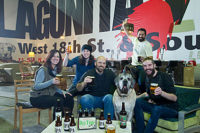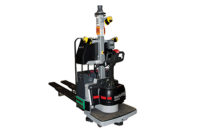Grupo Modelo’s Compañia Cervecera de Coahuila S.A. de C.V. in Piedras Negras, Mexico, is one of the most automated plants in the global beer industry, yet it still retains the mastery of making beer that the company has had since its inception, thus preserving the traditional quality of its brands.
The eighth and most recent plant in Grupo Modelo’s portfolio, the Compañia Cervecera de Coahuila has been called the “eighth wonder of Grupo Modelo.” Corona Extra production began March 28, 2010, in one of the most modern process plants in the world, which is a mark of pride for those who work at Grupo Modelo and in the Mexican village in general.
Construction began in June 2007 and ended in a record time of three years in 2010. The new plant allows the company to deal with global trends in the beer market, increase its leadership and meet Grupo Modelo’s objectives.
To select its location, Grupo Modelo made thorough investigations and projections for the construction, infrastructure and resources necessary for the development of its products. Coahuila, a state with experience in the livestock, coal and metallurgy industries that offers a strategic location, became the ideal candidate.
For the construction of this plant, a strategy was developed with adequate infrastructure both in personnel and materials to mitigate the impact on the environment with state-of-the-art technology and a highly qualified staff.
Plant design
Grupo Modelo staff applied the accumulation of knowledge acquired in other plants and improved some of the technologies with which they were already familiar. Throughout the process at Piedras Negras, they have applied the best technologies provided they do not impede with the methodology of making beer.
“We follow a maturation method known as krausening,” says Engineer Arturo Cadena Rios, director of brewing and malting processes for Grupo Modelo, S.A. de C.V. “This obliges us in each and every one of our brands to keep this special recipe, the formula for each brand from its origin. Each brand has its own methodology of maceration, fermentation and maturation.”
Planning, design and development of the plant’s construction was carried out by a team of engineers from Grupo Modelo.
“Through experience gained in other Grupo Modelo plants, we have been able to develop knowledge and experience to carry out this mega-project,” says Engineer Alejandro Correa Iturbe, director of engineering for Grupo Modelo. “We had multidisciplinary teams that extensively participated in the design, development and construction of the plant.
“At the time, we had the option to go to companies that specialize in this type of project, but for many years our staff has been trained through other projects within the company, and the result is a mega-plant with the characteristics that we wanted,” he concludes.
Grupo Modelo’s plant in Zacatecas was a good example because it is a mega-plant that produces 528 million gallons each year.
The cost of investment in this plant with its current capacity of 264 million gallons a year, in two phases of 132 million gallons each, was USD $600 million. The total area is 825 acres and is designed to be able to expand in the future. With the two phases, it currently occupies 252 acres, which gives them a margin of two-thirds to continue growing at 132 million gallons without disrupting production.
“In addition, it allows us vertical growth and in the future we will be able to install our own manufacturing of bottles, cartons, etc. This would provide a lower cost of production,” Alejandro Correa says.
The new plant has 650 employees, which represents a very high productivity, even taking into account production volume and size of the plant. The Compañia Cervecera de Coahuila produces Corona, Modelo Especial, Corona Light and in the future will produce Negra Modelo.
Within the cutting-edge technology, one will find a sewage treatment plant with aerobic and anaerobic treatments that has allowed them to satisfactorily comply with Mexican law.
Two premixers expedite production and allow the reach of 12 batches a day in each of the brewing tanks. Unitanks with fully automatic systems for the management of beer in the stages of fermentation, maturation and finished beer have a capacity of 264 million gallons each year. The brewery has the largest lauter filters in the world, the company says. Measuring nearly 50 feet in diameter each, their function is to filter the mash before moving on to the cooker.
In the brewing area is a single control room where all the variables of the process, ranging from grain reception until the beer is sent to packaging, have been centralized. Everything is controlled through double-function valve systems, process automation and activities, and high-tech equipment.
Packaging lines operate at a high-tech level. Laser-guided vehicles move all the inputs of the packaging production lines as well as the finished product from these lines. High-density warehouses keep sufficient levels of finished product inventory.
Unitanks: true applied technology
Fermentation and maturation processes are carried out in a single tank, which is why they call them “unitanks.” The plant has three sizes of tanks: the smallest has a capacity of 36,984 gallons, 26 medium tanks have a 142,653 gallon capacity and 42 tanks have a 324,932 gallon capacity. The tanks are filled to 75 percent capacity for fermentation and 98 percent for aging.
“They are called unitanks because when we previously had the conventional process, we had to ferment in a rectangular tank and mature in a cylindrical tank,” Arturo Cadena says. “Today, that process is held in a single tank. The savings is certainly extraordinary. We previously had a room where we refrigerated all the tanks whether they had or didn’t have beer; today we refrigerate only the tank that has beer. This is possible because the unitanks have coolant to cool only the tank that is needed.”
“In the 1980s, we tested processes with [79,352 gallon] tanks, later expanded to [211,338 gallon] and ended up with [317,006 gallon] tanks,” Alejandro Correa says. “This was a great accomplishment knowing that yeast is a microscopic organism of 5 microns in size, and with the static load, which [in the largest] tank [is 66 feet] in height, we had to refine the process very well so the fermentation does not suffer any deterioration, and we did it.
“The Zacatecas plant started with the concept of [317,006 gallon] tanks, but the difference in the new plant in Piedras Negras is that the process is fully automated with double-seat valves,” he continues. “Technology now allows a network of pipes to circulate a liquid on the one side and a different liquid on the other without mixing them. This gives us more flexibility, less length of pipelines and more control of the process.”
Another technological advancement is the distribution in a linear process. “Everything moves in one direction, pumping and the movement of all materials and products, in the same direction. This has allowed us to economize on space, energy, water and pipeline,” Alejandro Correa says.
Technological considerations
The packaging area consists of four lines — three for bottles that run 2,400 bottles a minute and a can line that operates at 1,200 cans a minute.
Machinery protects the integrity both of empty packaging and full containers through fully automated systems, which is a guarantee of quality for the products. The packaging technology allows them to be more productive and profitable. Although there is equipment that fills up to 2,200 cartons a minute in the market, the company decided on three fillers with speeds of 800 bottles a minute, a total of 2,400 a minute.
“The investment might be more expensive at the beginning, but productivity is more profitable because if a malfunction occurs, it can be corrected with minor loss of productivity (it’s not the same to stop production of 800 bottles versus 2,200 bottles per minute),” says Arturo Cadena. “In addition, the machine runs at a speed that does not sacrifice the equipment: there is no excessive wear and allows us to carry out the scheduled maintenance. Without this it would have more of an impact. True innovations are the double-seated automated valves that have not only made it possible to automate the process, but they represent substantial savings.”
Mechanical systems have been a part of the industry for hundreds of years, but is it possible that they will be displaced by robots? Alejandro Correa says it depends on the activity.
“There are activities where the robots are highly profitable, such as packaging where they are very efficient,” he says. “They are also excellent for routine activities, activities that present high distress to workers or when heavy lifting requires more people.”
For this plant, Grupo Modelo sought to apply proven technologies with well-known benefits. “We have not been closed-minded to new technologies, but yes, we want to be certain that it will bring savings or benefits to productivity,” says Arturo Cadena.
Some of the criteria for choosing a vendor are the quality of the products it offers, if it has proven technology, that it is a responsible company and that it is willing to be more of a strategic partner than a vendor.
Within this group of companies is Inamex de Cerveza y Malta S.A. de C.V., which has approximately 500 employees. Inamex has contracts for the transfer of technology with technical partners of Grupo Modelo and installed almost 90 percent of the equipment for the breweries. It participated in the manufacture and installation at a very high percentage.
“Inamex is our manufacturer for very large equipment, such as conical cylinder tanks that were assembled on the site; it is not possible to bring them assembled. Thanks to Inamex that manufactured and installed all of the tanks at Piedras Negras, we could finish the factory in record time,” says Alejandro Correa.
Sustainability plans
The issues of quality, employee safety and environmental control are priorities for Grupo Modelo regardless of whether the return on the investment is justified. An example of this is the masher housing where the temperatures can be extremely high. The equipment in this area of the plant is completely isolated.
Protection of the employees also was taken into account in the architectural design incorporating good ventilation and lighting, anti-skid floors, and appropriate sound levels.
“In the production process, we have systems to recover energy, save steam and automate dosing systems, which has involved much technology for control and monitoring of the process and achieved fuel savings,” says Arturo Cadena.
For the cleaning of the equipment, systems were developed that enable total sanitation with less intervention by staff and with the greatest possible safety and effectiveness.
“We are talking about tanks that are [66 feet] tall that are washed with a combination of machines and run-off,” explains Arturo Cadena. “This washing is done through a system of sprayers which distributes the liquid evenly like a film. This requires that the finished material and inside of the tank are suitable because there is a risk that if the drainage is not correct, crusts can form, and also to prevent the formation of beer stone.”
The plant takes into account the use of natural resources, such as water; proper chemical use; saving energy with low consumption lamps and sensors that turn on and off, thus not lighting areas that are empty; and systems designed to recover biogas, which is reused in the boilers.
A good portion of the water is reprocessed to be used in the plant; the water that is not reused is sent to a sewage treatment plant to be treated and returns to the sewer system in the manner required by the Mexican government’s standards. Many of the technologies applied in this mega-plant, such as energy consumption savings and more efficient water treatment, are being evaluated to see whether they should be replicated in other Grupo Modelo plants.
But one of the best uses of available technology is the high-density storage. “Despite similar storage in other areas, none is equal. In this case, it was tailored to the needs of Piedras Negras,” Alejandro Correa says.
They formerly had large areas of storage for empty packaging, finished product, etc. The high-density storage area measured approximately 394 feet by 492 feet with a height of 11 stories and exploits more space per square foot all together.
“Robots are programmed to locate the empty packaging, find a particular brand, etc., with millimeter precision. This allows the finished product to co-exist with the packaging, etc., and there is room for 72,000 positions,” Arturo Cadena says.
It is self-supported, fully automated and there are no workers within the area. Everything is robotic and automated to have real-time inventory and shipping. Product rotation is better and they have no waste.
Quality and distribution
The plant has various certifications to assure the quality of its processes and products as well as environmental care.
“Since we are exporting to more than 170 countries, we have to comply with the strictest quality standards and controls,” Arturo Cadena says. “We therefore have all the ISO certifications, but no less important are those required in the country, which are quite severe and mandatory. We have good manufacturing practices and go beyond other concepts.
“This plant has a very special feature, products are not stored for a long time nor are they kept empty or full for many days,” he continues. “We have equipment for microbiological detection of anaerobic sowings (five days) and aerobic (three days) and also have Milliflex equipment that uses bioluminescence technology with which we have the results within 24 hours. This gives us total security. We cannot afford the luxury of an error being only [9.3 miles] from the border of the United States.”
Because the majority of the Coahuila brewery’s production is exported to the United States, it has established security and distribution standards that are required by the country from both the logistical and profitability point of views.
Being as close as possible to its target — the American market — was paramount and that is why the plant is located in the municipality of Nava on one side of the city of Piedras Negras and at only 9.3 miles from the border.
The second is related to the concern about environmental pollution. Therefore, 85 percent of the distribution is done in containers that are sent by rail, which is both cheaper and cleaner, leaving only 15 percent distributed in trucks. In this plant, they also manufacture some non-returnable products sold in Mexico. The railcars leave organized by lots and have an established path, which is downloaded to distribution centers.
Team participation was integral in order to realize this marvel of Grupo Modelo. “Many factories provide their staff with many years of experience — young engineers are trained in Grupo Modelo’s plants where they can find the best teams to achieve the knowledge to be used later. Other collaborators supported the team that was at the forefront of the work from their positions in the office. Everyone participated actively in the project and this plant is the sum of the efforts of many people; it is the contribution of everyone,” Alejandro Correa says.
Arturo Cadena discloses, “Despite the problems of Mexico and the negative news that propagates globally about the country, it is well-known that there are people interested in getting things right and this plant is proof of this, which is a pride not only for those who work in Grupo Modelo, but for the whole country.”







